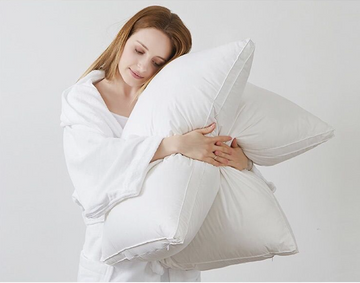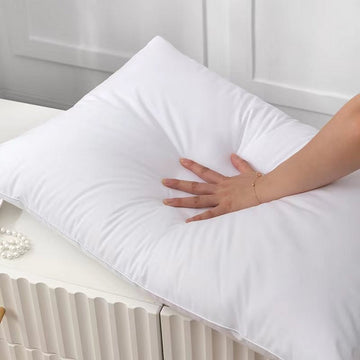The Science Behind Pillow Comfort
Understanding Material Properties and Comfort
The feel of a pillow hinges on its materials. These may include memory foam, down, or polyester. Each has unique traits that impact comfort. Memory foam molds to your shape for tailored support. Down is plush and traps heat, making it cozy. Polyester is budget-friendly and holds its shape well. But a pillow isn't just about softness. It must support the neck and head to prevent aches. The stuffing, cover fabric, and pillow design all play a role. They work together to give you a pillow that is both comfy and supportive. Choosing the right one can lead to better sleep and happier mornings.
The Role of Support and Softness in Pillow Design
The balance of support and softness is key in pillow design. A pillow must keep the head, neck, and spine aligned while sleeping. Too soft, and your head sinks in, straining the neck. Too firm, and it may cause pressure points and discomfort. Materials like memory foam can offer a mix of both, adapting to the shape of your head and neck. The ideal pillow is thus a personal choice, changing with sleep style and body size. It's vital to try different pillows to find the one that feels just right.
How Pillow Comfort Affects Sleep Quality
Sleep quality is vital for well-being. Pillow comfort plays a big role here. A comfy pillow can lead to deep, restful sleep. It can keep the head and neck aligned. This reduces pain and promotes better sleep patterns. Uncomfortable pillows can disrupt sleep and cause health issues. Bad pillows may lead to neck pain and poor sleep. To sleep well, choose a pillow that suits your sleeping style. This will improve your sleep quality and health.
Choosing the Right Pillow: Factors to Consider
Assessing Personal Needs and Sleeping Habits
When searching for the ideal comfort pillow, it's vital to consider personal needs and how you sleep. Side sleepers often need thicker pillows to fill the space between their head and mattress. Back sleepers may require firmer pillows to support their neck. Meanwhile, stomach sleepers usually benefit from soft, flat pillows. Beyond sleeping position, consider if you have allergies that could be triggered by certain materials. Finally, think about whether you prefer a cool pillow to combat night sweats. This personal assessment is key to finding a pillow that contributes to uninterrupted, restful sleep.
The Importance of Ergonomics and Health Benefits
The hunt for the perfect pillow often overlooks ergonomics and health. Yet, these are crucial. The right pillow aligns the spine, reducing pain. It also prevents strain on the neck and back. Over time, this promotes better posture. Plus, proper support may lessen headaches and improve sleep. Allergy sufferers should note pillow materials. Some hypoallergenic options could reduce symptoms. To sum up, picking a pillow with ergonomics in mind is wise for both comfort and health.
Comparing Different Types of Pillows
When searching for the ideal comfort pillow, knowing the types is key. Here are common options:
- Memory Foam Pillow: Molds to your shape, offering tailored support.
- Down Pillow: Soft and fluffy, made from duck or goose feathers.
- Latex Pillow: Resilient and supportive, it also resists dust mites.
- Microbead Pillow: Made with tiny beads that shift to contour your head.
Each type offers unique features. Think about your comfort and health needs when choosing.
Innovations in Pillow Comfort and Where to Find Them
Cutting-Edge Materials and Technologies in Pillow Manufacturing
Pillow manufacturing is evolving rapidly, with new materials and technologies redefining comfort. Memory foam is a standout, adapting to body shape for superb support. Cooling gels in pillows now offer a refreshing sleep experience, especially beneficial for those prone to overheating. Additionally, eco-friendly options are emerging, like organic latex and bamboo fibers. These materials are not only kind to the environment but also hypoallergenic. Furthermore, smart pillows featuring sleep tracking sensors help users monitor their sleep patterns. High-quality craft using these materials can often be found in specialty bedding stores or through online retailers. When looking for such innovations, reading customer reviews and looking for certifications, like CertiPUR-US for foam safety, is wise.
How to Spot High-Quality Pillows in the Market
To spot high-quality pillows, look for certain features. Key indicators include the material's breathability and durability. A good pillow should maintain its shape over time. This affects comfort and support. Check for certifications like CertiPUR-US or Oeko-Tex. These show the materials have passed safety and health standards. Look for pillows that offer warranty or sleep trials as well. This shows the maker stands by their product.
The Future of Pillow Comfort: What to Look Forward To
Looking ahead, pillow comfort is set to evolve with emerging technologies and design innovations. Expect to see smart pillows that can adjust firmness in real-time, adapting to your sleep position. We might also encounter sustainable materials that offer both comfort and eco-friendliness. As research into sleep patterns advances, pillow designs will become more customized. This future landscape promises a range of options that not only ensure a good night’s sleep but also contribute to overall well-being. Stay tuned as the world of pillow comfort moves towards a more personalized and environmentally conscious approach.







